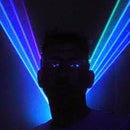Introduction: Body-ultrasound Sonography With Arduino
Hello!
My hobby and passion is to realize physics projects. One of my last work is about ultrasonic sonography. As always I tried to make it as simple as possible with parts you can get on ebay or aliexpress. So let's take a look how far I can go with my simple items...
I was inspired by this a bit more complicated and more expensive project:
https://hackaday.io/project/9281-murgen-open-sourc...
Here are the parts you'll need for my project:
the main parts:
- a gauge to measure the thickness of paint for 40 USD: ebay paint thickness gauge GM100
- or just the 5 MHz transducer for 33 USD: ebay 5 MHz transducer
- an arduino Due for 12 USD: ebay arduino due
- a 320x480 pixel display for 11 USD: 320x480 arduino display
- two 9V/1A power supplies for the symmetric +9/GND/-9V supply
- ultrasound-gel for sonography: 10 USD ultrasound gel
for the transmitter:
- a step-up-converter for the needed 100V for 5 USD: 100V boost converter
- a common step-up-converter supplying 12-15V for the 100V-boost-converter for 2 USD: XL6009 boost-converter
- a LM7805 voltage regulator
- monoflop-IC 74121
- mosfet-driver ICL7667
- IRL620 mosfet: IRL620
- capacitors with 1nF (1x), 50pF (1x), 0.1µF (1x electrolytic), 47µF (1x electrolytic), 20 µF (1 x electrolytic for 200V), 100 nF (2x MKP for 200V: 100nF20µF
- resistors with 3kOhm (0.25W), 10kOhm (0.25W) and 50Ohm (1W)
- 10 kOhm potentiometer
- 2 pcs. C5-sockets: 7 USD C5 socket
for the receiver:
- 3 pcs. AD811 operational amplifie: ebay AD811
- 1 pcs. LM7171 operational amplifie: ebay LM7171
- 5 x 1 nF capacitor, 8 x 100nF capacitor
- 4 x 10 kOhm potentiometer
- 1 x 100 kOhm potentiometer
- 0.25W resistors with 68 Ohm, 330 Ohm (2 pcs.), 820 Ohm, 470 Ohm, 1.5 kOhm, 1 kOhm, 100 Ohm
- 1N4148 diodes (2 pcs.)
- 3.3V zener diode (1 pcs.)
Step 1: My Transmitter- and Receiver-circuits
Sonography is a very important way in medicine to look inside the body. The principle is simple: A transmitter sends ultra-sonic-pulses. They spread out in the body, are being reflected by inner organs or bones and come back to the receiver.
In my case I use the gauge GM100 for measuring the thickness of paint layers. Though not really intended for looking inside the body i am able to see my bones.
The GM100-transmitter works with a frequency of 5 MHz. Therefore you have to create very short pulses with a length of 100-200 nanoseconds. The 7412-monoflop is able to create such short pulses. These short pulses go to the ICL7667-mosfet-driver, which drives the gate of an IRL620 (attention: the mosfet must be able to handle voltages up to 200V!).
If the gate is switched on, the 100V-100nF-capacitor discharges and a negative pulse of -100V is applied to the transmitter-piezo.
The ultrasonic-echoes, received from the GM100-head are going to a 3-stage amplifier with the fast OPA AD820. After the third step you'll need a precision-rectifier. For this purpose I use an LM7171 operational amplifier.
Pay attention: I got the best results, when I shorten the input of the precision-rectifier with a dupont-wire-loop (? in the circuit). I don't really understand why but you'll have to check it if you try to reconstruct my ultrasonic-scanner.
Step 2: The Arduino-software
The reflected pulses have to be stored and displayed by a microcontroller. The microcontroller must be fast. Therefore I choose an arduino due. I've tried two different types of fast analog-read-codes (look at the attachments). One is faster (about 0.4 µs per conversion) but I got 2-3 times the same value when reading in the analog input. The other one is a bit slower (1 µs per conversion), but hasn't the disadvantage of the repeated-values. I've chosen the first one...
There are two switches on the receiver-board. With those sitches you can stop the measurement and choose two different time-bases. One for measure-times between 0 and 120 µs and the other between 0 and 240 µs. I realized this by reading out 300 values or 600 values. For 600 values it takes twice the time, but then I take just every second analog-in-value.
The incoming echoes are being read with one of the analog-input-ports of the arduino. The zener-diode should protect the port for too high voltages because the arduino due can only read voltages up to 3.3V.
Each analog-input-value is then transformed into an value between 0 and 255. With this value a further grey-coloured-rectancle will be drawn on the display. White means high signal/echo, dark-grey or black means low signal/echo.
Here are the lines in the code for drawing the rectangles with 24 pixel width and 1 pixel height
for(i = 0; i < 300; i++)
{
values[i] = map(values[i], 0, 4095, 0, 255);
myGLCD.setColor(values[i], values[i], values[i]);
myGLCD.fillRect(j * 24, 15 + i, j * 24 + 23, 15 + i);
}
After one second the next column will be drawn...
Step 3: Results
I've examined different objects from aluminim-cylinders over water-filled balloons to my body. To see body-echos the amplification of the signals must be very high. For the aluminum-cylinders a lower amplification is needed. When you look at the pictures you can clearly see the echoes from the skin and my bone.
So what can I say about the success or failure of this project. It is possible to look inside the body with such simple methods and using parts, which aren't commonly intended for that purpose. But these factors are limiting the results too. You don't get such clear and well structured pictures compared with commercial solutions.
But and this is the most important thing, I've tried it and did my best. I hope you liked this instructables and it was at least interesting for you.
If you like to take a look at my other physics-projects:
https://www.youtube.com/user/stopperl16/videos?
more physics projects: https://stoppi-homemade-physics.de/






